
About UsThe Numismatic Bibliomania Society is a non-profit organization promoting numismatic literature. For more information please see our web site at coinbooks.org SubscriptionsThose wishing to become new E-Sylum subscribers (or wishing to Unsubscribe) can go to the following web page link MembershipThere is a membership application available on the web site Membership Application To join, print the application and return it with your check to the address printed on the application. Membership is only $15 to addresses in the U.S., $20 for First Class mail, and $25 elsewhere. For those without web access, write to: David M. Sundman, Secretary/TreasurerNumismatic Bibliomania
Society AsylumFor Asylum mailing address changes and other membership questions, contact David at this email address: dsundman@LittletonCoin.com SubmissionsTo submit items for publication in The E-Sylum, just Reply to this message, or write to the Editor at this address: whomren@coinlibrary.com
BUY THE BOOK BEFORE THE COINYou won't regret it! |
- WAYNE'S WORDS: THE E-SYLUM JANUARY 9, 2011
- KOLBE & FANNING 2011 NEW YORK SALE HIGHLIGHTS
- LAKE BOOKS 106TH MAIL-BID SALE FEBRUARY 8, 2011
- NEW EDITION: STANDARD CATALOG OF WORLD COINS 1701-1800, 5TH EDITION
- NEW EDITION: GUIDE BOOK OF UNITED STATES PAPER MONEY, THIRD EDITION
- MORE ON THE SANDINO'S LEAD 10 PESOS
- AN INTERESTING MEXICO CITY NECESSITY COIN OF FERDINAND VII
- THE AMERICAN NUMISMATIST
- TREASURE IN THE CELLAR CHOCOLATE COINS
- WINSTON CHURCHILL ON COINS AND MEDALS
- ON READABLE BRAILLE CHARACTERS ON COINS
- FEDERAL NEWS RADIO INTERVIEW WITH MINT DIRECTOR ED MOY
- ON U.S. MINT DIRECTOR TENURES
- QUERY: BIRTH DATES OF ANA NUMISMATIC HALL OF FAMERS
- QUERY: DID THE U.S. MINT MAKE EMBLEMS FOR THE MARINE CORPS?
- NOTES FROM E-SYLUM READERS: JANUARY 9, 2011
- WAYNE'S NUMISMATIC DIARY: JANUARY 9, 2011
- ROBERT HENDERSON AND THE SHERATON COIN COMPANY
- MARK HOROWITZ' LARGE CENT LEARNING EXPERIENCE
- STEPPING THE MAST: COINS OF THE BLUENOSE II
- SPELLING MISTAKE FOUND ON 2005 £2 COIN
- PARKS CANADA COIN CRITICIZED
- ESTONIA REARRANGES THE NUMISMATIC MAP
- TOURISTS LOVE ZIMBABWE 100 TRILLION DOLLAR BANKNOTES
- FEATURED WEB SITE: COIN PROJECT
WAYNE'S WORDS: THE E-SYLUM JANUARY 9, 2011

Among our new subscribers this week is J. Isles. Welcome aboard! We now have 1,393 email subscribers, plus 105 followers on Facebook, including Jeffrey Swindling and Timothy Grat.
This week we open with updates from David Fanning and Fred Lake and announcements of two new numismatic book editions. Next, we have more information on that lead Nicaraguan emergency coin, and a note on another intriguing necessity coin of Mexico.
Other topics include Winston Churchill on coins and medals, Braille characters on coins, Mint Director tenures, and Large Cent collector Robert Henderson.
To learn more about The American Numismatist, Len Augsburger's chocolate coins, the Sheraton Coin Company, the Royal Mint's spelling mistake and a "counterstamped overstruck countermarked cast modified imaginary bust type coin", read on. Have a great week, everyone!
Wayne Homren
Numismatic Bibliomania Society
KOLBE & FANNING 2011 NEW YORK SALE HIGHLIGHTS
 Kolbe & Fanning Numismatic Booksellers held their 2011 New York Sale on Saturday in conjunction with the New York International Numismatic Convention. The sale featured 500 lots of high-quality numismatic literature and was a resounding success, bringing 137% of the total estimated value of the lots. A few highlights included:
Kolbe & Fanning Numismatic Booksellers held their 2011 New York Sale on Saturday in conjunction with the New York International Numismatic Convention. The sale featured 500 lots of high-quality numismatic literature and was a resounding success, bringing 137% of the total estimated value of the lots. A few highlights included:
-- lot 8, a set of Ernest Babelon's Traité des monnaies grecques et romaines, which brought $20,000 hammer
-- lot 225, a well-preserved set of the French edition of Grand Duke Mikhailovitch on Russian coins, which brought $22,000 hammer,
-- lot 418, Sylvester S. Crosby's deluxe bound copy of his Early Coins of America, which brought $30,000 hammer
-- lot 482, a remarkable archive of correspondence to and from dealer Michael Powills, which brought $24,000 hammer.
Total proceeds of the sale, including buyers' premiums, exceeded half a million dollars.
Kolbe & Fanning are actively seeking consignments for their 2012 New York Sale, to be held January 7, 2012 in New York City. The firm is also interested in purchasing outstanding numismatic books or entire libraries outright. Please contact David Fanning at df@numislit.com or George Kolbe at gfk@numislit.com for details. The firm's office may be reached at (614) 414-0855.
LAKE BOOKS 106TH MAIL-BID SALE FEBRUARY 8, 2011
Lake Books announces that its 106th mail-bid sale of numismatic literature will be available for viewing on their web site on January 10, 2011 at http://www.lakebooks.com/current.html
The 507-lot sale features selections from the libraries of several eminent collectors and has a closing date of February 8, 2011. A complete run of John J. Ford Jr. sale catalogs (21 numbers) is listed as are reference books in the areas of Tokens and Medals, Paper Money (including a set of Haxby's), U.S. and World Guides, Ancient Coins, etc.
Bids may be sent via email (fredlake@tampabay.rr.com), telephone, fax, or regular mail until the closing time of 5:00 PM (EST) on Feb.8th.
Good Luck with your bidding, Fred
Lake Books
6822 22nd Ave. N.
St. Petersburg, FL 33710
727-343-8055 Fax 727-345-3750
http://www.lakebooks.com
NEW EDITION: STANDARD CATALOG OF WORLD COINS 1701-1800, 5TH EDITION
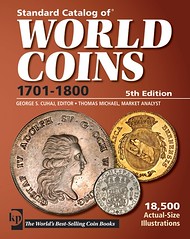 The Standard Catalog of World Coins 1701-1800 is now available from Krause Publications.
The Standard Catalog of World Coins 1701-1800 is now available from Krause Publications.
The fifth edition of this must-have reference contains 1,352 pages and more than actual-size 20,000 images. The book contains values in up to five grades of condition, reflecting dramatic changes in values for gold coins and silver crowns.
Other features include:
-Significant price increases for coins of Austria and Hungary.
-Extensive additions to listings for German states and Italian states.
--Expanded and improved coin images.
For more information visit
www.shopnumismaster.com/product/standard-catalog-of-world-coins
-1701-1800-5th-edition
.
Editor George S. Cuhaj is a 16-year veteran of Krause Publications' Numismatic Catalog Division, where he is also the editor of the Standard Catalog of® World Coins series. Cuhaj hails from New York City, where he was previously on staff with the American Numismatic Society, Stack's Rare Coins and R.M. Smythe & Co. He is a frequent instructor at the American Numismatic Association's Summer Seminars. Market Analyst Tom Michael serves as market analyst for Krause Publications coin catalogs, and has done so for more than 90 world and U.S. coin catalogs. He has more than 20 years of experience researching and reporting on world coin prices and market trends.
NEW EDITION: GUIDE BOOK OF UNITED STATES PAPER MONEY, THIRD EDITION
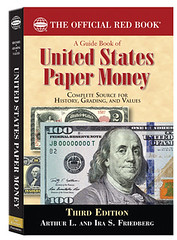 Building on the scope of Robert Friedberg's groundbreaking research, the Guide Book of United States Paper Money, third edition, is an engaging history and price guide of the paper currency of the United States. The full-color, 416-page book is available for $24.95 online (including at WhitmanBooks.com) and from booksellers nationwide.
Building on the scope of Robert Friedberg's groundbreaking research, the Guide Book of United States Paper Money, third edition, is an engaging history and price guide of the paper currency of the United States. The full-color, 416-page book is available for $24.95 online (including at WhitmanBooks.com) and from booksellers nationwide.
Every federal note—from the ultra rare Demand Notes of 1861 to the lunch money in our wallets today—is described in detail. Fascinating narrative captures the romance and history of American paper money, and also explores recent developments in the hobby and market. The book combines the hobby-standard Friedberg numbering system with retail values in multiple grades and hundreds of high-resolution photos.
"The first and second editions have been very popular among collectors and dealers," said Whitman publisher Dennis Tucker. "Since the first edition was published in 2005, we've seen interest in paper money increasing within the hobby community, and also among new collectors. The third edition of the Guide Book of United States Paper Money is designed for both newcomers and longtime hobbyists."
Authors Arthur and Ira Friedberg are well known in the numismatic world. They have been professional numismatists for more than 30 years. Both joined their father's family firm, The Coin & Currency Institute, after college. Since then they have established themselves as award-winning authors, coin dealers, researchers, and numismatic consultants to numerous governments and organizations.
Authors: Arthur L. and Ira S. Friedberg
Introduction by David L. Ganz
ISBN 0794832407
Full color, illustrated. 416 pages.
6 x 9 inches. Softcover.
Retail $24.95
THE BOOK BAZARRE
MORE ON THE SANDINO'S LEAD 10 PESOS
I was fascinated by the piece on Sandino's lead 10 Pesos coin submitted by Dennis Tucker from Ken Bresset's book Milestone Coins.
I have never seen the unique piece illustrated in The E-Sylum (Vol. 14 #1) nor even heard about it prior to this article. I have heard that shortly after the revolution of 1979 some unscrupulous Sandinistas "manufactured" replicas of the rare Sandino piece in lead in response to demand for more rare coins after a few (not Sandino pieces) had been looted from the collection of Banco Central.
I have never seen one of these modern fabrications, and was wondering if Mr. Bressett could tell us a little about the provenance of the interesting and supposedly unique piece he illustrates. For reference, attached is an illustration of a genuine piece (made by Sandino in August 1927) said to have been brought back to the United States in the 1930's in the hands of one of the U.S. Marines who had just served a tour of duty there.
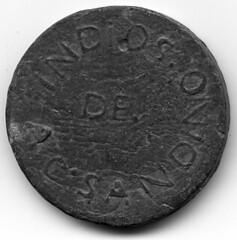
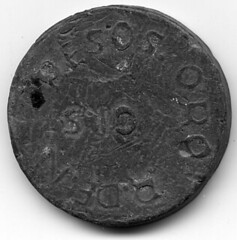
The earliest notice of these pieces can be found on page 100 of the February 1928 issue of The Numismatist, and an interesting write-up on these pieces can be found on page 52 of the April 1964 Whitman Numismatic Journal, which account closely parallels the fascinating historical background presented by Mr. Bressett.
Ken Bressett writes:
In response to Alan Luedeking's request for additional information about the lead Sandino 10 Pesos ‘coins', I can add the following:
Two unquestionably genuine specimens of these lead pieces were acquired in Nicaragua at the time of the revolution. They were obtained by Marine Corps General M. Stanley Newton who was deployed there to quell the revolt. General Newton, an experienced numismatist, is well known for his extensive collection of United States coins (perhaps second only to the Eliasberg collection) that included examples of nearly every date and mint of all gold, silver, nickel and copper coins. His U.S. coins were eventually sold by RARCOA at the Chicago ANA auction August 18-22, 1970.
General Newton was not only a numismatic colleague but also a close personal friend of mine who, in his retirement, lived close by. We visited often. He frequently recounted his military experiences in China and Nicaragua and spoke often of the unusual Sandino coins that were some of his favorite numismatic items. Unfortunately, he died unexpectedly in 1970 at age 67. At that time his two Sandino coins were gifted to me as a special gesture of friendship.
One of these pieces is of the exact type shown in Mr. Luedeking's attachment. Over the years I have seen pictures of a few others of this variety. The second piece that I obtained from the Newton gift is the variety with a retrograde dollar sign that is used to illustrate my article in Milestone Coins. I have never seen or heard of another specimen of this variety, and believe that it may be unique. The composition, style and lettering of both pieces are similar. The first coin, however, is in wretched condition and barely discernable. It is illustrated in an article written by me and General Newton in the Whitman Numismatic Journal in 1964. The General also composed a similar article that was published in Numismatic Gallery Monthly, May-June 1950.
To read the earlier E-Sylum article, see: AGUSTO CÉSAR SANDINO OF NICARAGUA, ALCHEMIST (www.coinbooks.org/esylum_v14n01a10.html)
AN INTERESTING MEXICO CITY NECESSITY COIN OF FERDINAND VII
 In 1808, Charles IV, King of Spain, handed over the crown to his son, Ferdinand VII. As one of the most productive mints in the Spanish empire, Mexico City needed to continue striking coins, but now they had to do it under the name of the new ruler. The problem was, however, that they did not have the new official coin designs yet. And worse, with the Spanish motherland occupied by the French, new designs were not going to be sent out in the near future.
So the Mexico City mint officials designed and engraved an imaginary bust of how the people in Mexico thought their new king might look like.
In 1808, Charles IV, King of Spain, handed over the crown to his son, Ferdinand VII. As one of the most productive mints in the Spanish empire, Mexico City needed to continue striking coins, but now they had to do it under the name of the new ruler. The problem was, however, that they did not have the new official coin designs yet. And worse, with the Spanish motherland occupied by the French, new designs were not going to be sent out in the near future.
So the Mexico City mint officials designed and engraved an imaginary bust of how the people in Mexico thought their new king might look like.
Then the War for Independence started. The city of Chihuahua set up its own coinage operations when it became increasingly difficult to transport the silver mined in the region to the capital, straight through territories plagued by insurgents, rebels and bandits. Little coining equipment was available in the beginning, and no dies, so the coins were cast, using the circulating coins with the imaginary bust from Mexico as models. The design was modified to show the new mint mark CA for Chihuahua. To make sure that the people accepted these crudely looking coins, two marks were applied, a T for the Treasurer and a pomegranate between two crowned pillars as symbol of the comptroller.
When in later years the regular dies did reach not only Mexico but also the mint in Chihuahua - now bearing the official portrait bust of Ferdinand VII used all throughout the Spanish empire -, all the makeshift coins the people in the mint of Chihuahua could find were overstruck with the new dies and the official portrait.
Some of these coins then circulated in the territories where the Royalists fought with the Insurgents, and again, to prove the validity of the coins, further counterstamp were applied – in our case, "LCM", which is assumed to stand for "La Comandancia Militar" .
Thus the pictured item came into existence and now serves as a vivid example of Mexico's turbulent past – as a counterstamped overstruck countermarked cast modified imaginary bust type necessity coin!
In 1808, Charles IV, King of Spain, handed over the crown to his son, Ferdinand VII. As one of the most productive mints in the Spanish empire, Mexico City needed to continue striking coins, but now they had to do it under the name of the new ruler. The problem was, however, that they did not have the new official coin designs yet. And worse, with the Spanish motherland occupied by the French, new designs were not going to be sent out in the near future. So the Mexico City mint officials designed and engraved an imaginary bust of how the people in Mexico thought their new king might look like.
Then the War for Independence started. The city of Chihuahua set up its own coinage operations when it became increasingly difficult to transport the silver mined in the region to the capital, straight through territories plagued by insurgents, rebels and bandits. Little coining equipment was available in the beginning, and no dies, so the coins were cast, using the circulating coins with the imaginary bust from Mexico as models. The design was modified to show the new mint mark CA for Chihuahua. To make sure that the people accepted these crudely looking coins, two marks were applied, a T for the Treasurer and a pomegranate between two crowned pillars as symbol of the comptroller.
When in later years the regular dies did reach not only Mexico but also the mint in Chihuahua - now bearing the official portrait bust of Ferdinand VII used all throughout the Spanish empire -, all the makeshift coins the people in the mint of Chihuahua could find were overstruck with the new dies and the official portrait.
Some of these coins then circulated in the territories where the Royalists fought with the Insurgents, and again, to prove the validity of the coins, further counterstamp were applied – in our case, "LCM", which is assumed to stand for "La Comandancia Militar" .
Thus the pictured item came into existence and now serves as a vivid example of Mexico's turbulent past – as a counterstamped overstruck countermarked cast modified imaginary bust type necessity coin!
To read the complete Facebook item, see: Ralf W. Böpple's Photos - A New Year's Greetings to my fellow numismatists! (www.facebook.com/photo.php?fbid=1507831339163&set=p.1507831339163)
THE AMERICAN NUMISMATIST
I have often seen the statement: The Numismatist was originally published as a four page leaflet in 1888 by Dr. George F. Heath in Chicago. Since I didn't remember ever seeing that very first issue, I asked the great ANA staff in Colorado Springs to send me scans of that seminal issue.
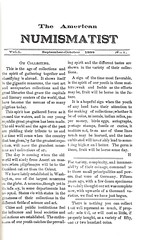
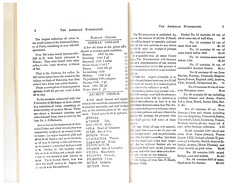
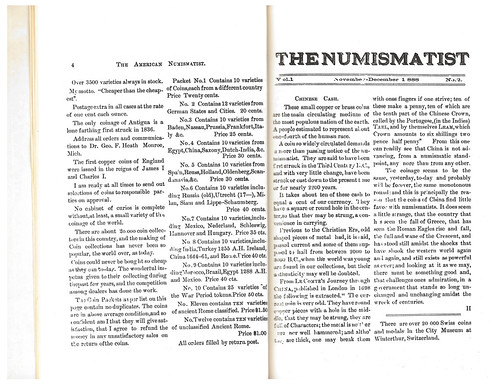
On the ANA web site they give more information about the origin and history of The Numismatist.
From 1888 to 1908 Heath printed, published and distributed THE NUMISMATIST, in which he listed his coin needs, advertised duplicates for sale, and discussed numismatic topics. It evolved into much more than a dealer newsletter during this period.
On June 16, 1908, Dr. Heath suddenly died. Farran Zerbe, then [ANA] president, assumed the task of editing and publishing THE NUMISMATIST, and soon purchased the publication from Heath's heirs. In 1911, through the generosity of W.C.C. Wilson of Montreal, Canada, THE NUMISMATIST was purchased from Zerbe and presented to the ANA. The magazine has been owned and published monthly by the Association since that time.
As a trivia nut, what caught my attention was that the very first issue (VOL 1, No 1) was titled The American NUMISMATIST. Starting with the second issue for November-December 1888 it was titled THE NUMISMATIST (see scans). And except for the short time during the Capoletti era when the name was shortened to NUMISMATIST, the name persists to this day.
TREASURE IN THE CELLAR CHOCOLATE COINS
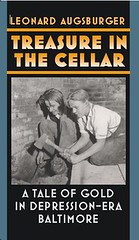 In conjunction with the launch of my book, Treasure in the Cellar, at the Baltimore 2008 American Numismatic Association convention, I had a thousand chocolate coins "minted" with an image of a $20 coronet gold piece on the obverse and the book website URL on the reverse. The $20 obverse was electronically rendered from the image of an actual Baltimore hoard coin.
In conjunction with the launch of my book, Treasure in the Cellar, at the Baltimore 2008 American Numismatic Association convention, I had a thousand chocolate coins "minted" with an image of a $20 coronet gold piece on the obverse and the book website URL on the reverse. The $20 obverse was electronically rendered from the image of an actual Baltimore hoard coin.
The coins were shipped in dry ice from Texas to the convention hotel, where they were hand carried into the bourse in order to avoid premature meltage. A few people who stopped by the table indicated that they collected chocolate coins, and some speculation was offered as to whether they ought be "slabbed."
One young man, who should have known better, decided to start his own Baltimore hoard, and stopped by the table about every two minutes for the better part of a day. If he got an upset stomach he certainly deserved it.
Other than that, the coins were graciously received by just about everyone else. They are not terribly expensive to produce, as I recall we spent a couple hundred dollars on the whole batch. Somewhere in the archives one remains, and I believe a few others saved theirs as well.
To read the earlier E-Sylum article, see: CHOCOLATE COINS, ATTRIBUTED AND PRICE-CODED (www.coinbooks.org/esylum_v14n01a18.html)
WINSTON CHURCHILL ON COINS AND MEDALS
The January issue of The Numismatist arrived this week with an article, page 33, on the British Churchill crown (KM 910). The author, Todd Sciore, mentions the obverse Queen's portrait on this coin is by sculptor Mary Gillick. But he fails to mention the reverse -- with the portrait of Winston Churchill -- was by famed sculptor Oscar Nemon (1906-1985).
Nemon was extremely dissatisfied with the portrait in its final form on this 1965 coin. His original design was rendered into a flat, detail-less appearance by the British Royal Mint. Granted, it had to be struck with a single blow on the Mint's coining presses, so Mint engravers greatly reduced Nemon's higher relief portrait model and in so doing removed a major portion of the facial detail.
Three years later an American, Neil S. Cooper, met Nemon who again expressed his dissatisfaction with the coin's appearance. Ironically enough, Cooper was a publisher of medals in New York City. "Can I issue a Churchill medal with the portrait you wanted to appear on that coin?" Cooper asked Nemon.
Nemon was delighted with the offer. Since the 25th anniversary of D-Day -- end of the war in Europe -- was approaching in 1969, Neil and Nemon decided this should be the theme of the new issue. Nemon dusted off his original Churchill portrait, unhurriedly reworked that Churchill portrait, added the lettering '"D-DAY 1944" under the portrait, and prepared an appropriate reverse of the Churchill family coat of arms.
He shipped both models to Cooper in New York City. He'd show those Royal Mint officials -- and the world! -- what his interpretation of the great British statesman should exhibit, what should have appeared on that 1965 coin.
Neil Cooper was somewhat of a numismatic gadfly. In the 1950s he and his brother had traveled the world and noted the coins in circulation in parts of the world. He came up with the idea of issuing coins for areas which did not have their own. He established International Numismatic Agency, had coins first made for Gardiners Island struck at Franklin Mint. Other Franklin Mint productions followed, including a four-coin set for Malta, the Knights of Malta, modeled by Ed Grove, and a five-coin set for the Greek Order of St. Dennis of Zante, modeled by Gilroy Roberts of Franklin Mint.
He settled in New York City and married an art dealer. With her new married name, she established Paula Cooper Art Gallery and the pair circulated among the high end Art World in both America and Europe. Her artist friends were some of the most prominent in the field. These included Marcel Duchamp, Roy Lichtenstein, Jean Arp, and hundreds of others.
But it was natural for Neil to have met Oscar Nemon. Neil was not a name-dropper, but had a charming ability to influence top-name artists to create models he could promote, just as his wife could sell their art work. Nemon gladly agreed for this likeable American entrepreneur to produce and promote a medal of his Churchill portrait. The Paula-Neil team prospered but the marriage didn't last. The Paula Cooper Art Gallery, however, is still in existence.
Neil recognized the limited ability of Franklin Mint issuing only proof surface coins and medals. He turned to Medallic Art Company, also in New York City at that time, for a relationship that lasted over a decade. It was a foregone conclusion that Nemon's models should be struck by Medallic Art.
The stunning medal was struck by the firm (catalog number 1970-11) bearing Nemon's outstanding portrait. It is one of more than two dozen art medals of Neil Cooper's issues.
In the catalog of Winston Churchill Medals by American J. Eric Engstrom -- isn't it interesting Americans venerate British medals? -- he had this to say about that medal:
This important portrait piece, by the designer of the Churchill Crown, is the artist's definitive medallic portrait of Churchill. Its vital style conveys the same energy as the artist's other Churchill works; the siren-suited bust at Windsor, the statue in the House of Commons, and the commemorative crown. The artist prepared several models before the final model was complete in 1969.
While I read that article in the January issue of The Numismatist, I was amazed the author had not done enough research on his subject. He neglected to even mention the artist's name!
ON READABLE BRAILLE CHARACTERS ON COINS
Jeff Kelley writes:
A recent piece on the resignation of U.S. Mint Director Ed Moy mentioned that under Moy's tenure the Mint "released the first U.S. coins with readable Braille characters." An E-Sylum reader differed with this claim and commented that "the first coin with Braille characters was the 2003 Alabama state quarter and therefore was not minted during Moy's tenure as Director."
The operative word in the original article's claim is "readable". While the Alabama quarter is the first US coin to portray Braille characters, they are not "readable" - that is, they are too small to be read by a person who uses Braille. The first coin to use "readable" Braille characters (readable by those who use it) was indeed under Moy's tenure.
To read the earlier E-Sylum article, see: NOTES FROM E-SYLUM READERS: JANUARY 2, 2011 (www.coinbooks.org/esylum_v14n01a06.html)
FEDERAL NEWS RADIO INTERVIEW WITH MINT DIRECTOR ED MOY
 The workforce at the Mint is a great example of a passion for or a calling to public service, said Moy. "Many of our Mint employees have 30 to 45 years experience. Once they get to the Mint, they absolutely love it and they are passionate about what they do and they want to do that for the rest of their lives." Moy invited listeners to visit the Mint and take the public tours in Philadelphia and Denver, and "just say Ed Moy sent ya'."
The workforce at the Mint is a great example of a passion for or a calling to public service, said Moy. "Many of our Mint employees have 30 to 45 years experience. Once they get to the Mint, they absolutely love it and they are passionate about what they do and they want to do that for the rest of their lives." Moy invited listeners to visit the Mint and take the public tours in Philadelphia and Denver, and "just say Ed Moy sent ya'."
With that much commitment, why resign as the director? Moy said his five year term ends in August and he felt the need to "start thinking about what comes next, and I just had an opportunity to check off something from my bucket list which is to work for a rapidly growing, publicly held company."
Moy takes with him a proven talent for turning a profit.
Before 1999, he said, the most amount of change made to most coins was only to reflect the year the coin was minted. During his tenure, he increased revenues from $2.3 billion to a record $4 billion and increased profits from $350 million to over $1 billion.
Moy gave huge credit for that to the popularity of the state quarters. "With the fifty state quarter program," explained Moy, "we probably made 300 percent more quarters than what would normally be needed in the economy and that brought about six and a half billion dollars of profit that went directly to the taxpayers."
And that was one quarter at a time.
"The most fascinating thing about Director Moy," according to David Ganz, a former president of the American Numismatic Association in a coinbooks.com interview, "is that as a kid he worked in his parent's Chinese restaurant and as a cashier he used to go through the cash draw every night and pick out coins for his coin collection."
Moy said the job was part of what was expected in his family.
Yup, I grew up in a restaurant and in a Chinese family, you have the family man the cash register because that's who you trusted with the money, and as a bored kid, I used to just go through the change. And what I noticed was all the different designs. It could be the same denomination but you'd have an Indian Head penny or a Lincoln penny, or a Lincoln penny with wheat on the back or the Lincoln Memorial on the back and that's how I got started in my collection. And this is how great of a country we are. I did that when I was ten years old. Forty years later, I could never imagine I'd become the director of the U.S. Mint.
To read the complete article, see: Big change in store for the director of the U.S. Mint (www.federalnewsradio.com/index.php?nid=15&sid=2224070)
ON U.S. MINT DIRECTOR TENURES
While catching up with my reading, I was reading the December 26 E-Sylum and found an example of a generalization that drives me crazy. In the note about U.S. Mint Director Ed Moy's resignation, David Ganz was quoted as saying, "If you look back 50 years, there's no Mint director that has served a full term when there has been a change of administration." There was something about this statement that bothered me, so I looked back to the last 50 years and found:
- Eva Adams, appointed by Kennedy in 1961, was reappointed by Johnson in 1966, and resigned in August 1969 after Nixon was in the White House.
- Mary Brooks was appointed by Nixon in 1969, reappointed by Ford in 1974 (Nixon had resigned by then), and served until February 1977 after Carter took office.
- Stella Sims was appointed by Carter and resigned in April 1981 under Reagan.
- Donna Pope was appointed by Reagan in April 1981, confirmed in July 1981, and reappointed by Reagan in 1986. Pope served her full second term leaving office August 1991 under the administration of George H.W. Bush.
- David J. Ryder was nominated by George H.W. Bush in July 1991 but was not confirmed until September 1992. Ryder served until November 1993 while Clinton was in office. Ganz can explain why the confirmation was help up since he was the attorney representing PNG at the hearing.
- Jay Johnson was appointed by Clinton in May 2000 and served under Bush 43 until August 2001.
While it may be fair to say that Brooks, Sims, Ryder, and Johnson resigned on the change of administrations, it is clear that Adams and Pope did not.
The Coinage Act of 1873 set the term of the U.S. Mint Director to five years. The law does not require the director to resign on the change of administration. On the contrary, the reason for setting the term to five years is to purposely span administrations and "try" to keep politics out of the process.
Not including cabinet secretaries, it is more common for appointed directors and commissioners of bureaus to serve across presidential terms. For example, Doug Shulman, the current commissioner of the IRS who also serves a five-year term, was appointed by George W. Bush and confirmed in March 2008.
I love David Ganz's writing, but he should reconsider his use of generalizations.
To read the earlier E-Sylum article, see: U.S. MINT DIRECTOR ED MOY RESIGNS (www.coinbooks.org/esylum_v13n52a13.html)
QUERY: BIRTH DATES OF ANA NUMISMATIC HALL OF FAMERS
I am attempting to provide the date of birth and date of death for each member of the ANA Numismatic Hall of Fame. I am currently missing five of the dates of birth and would appreciate help from any reader who may have better sources than mine. Here are the names:
- Ole Eklund
- S. Wolcott Freeman
- Barclay Head
- B. Max Mehl
- Stuart Mosher
Please forward any responses through Wayne and The E-Sylum.
QUERY: DID THE U.S. MINT MAKE EMBLEMS FOR THE MARINE CORPS?
Jim Phillips writes (to Dave Bowers):
My name is Jim Phillips. We run a small specialty publishing company. One of my authors, Dr. Fred Brier, is currently working on a two volume history of the Marine Corps Emblem known as the EGA.
Recently, we were told an interesting tidbit, that we can't verify. We were told that during the 1920's and 30's the US Mint in Philadelphia made emblems for the Marine Corps.
In all the years he has been researching the subject, we have never come across any reference to support such a claim.
I thought if there is anyone in the USA that might know, you'd be that person.
Coins, medals, medallions certainly, but insignia? We're stumped. Can you help?
Thank you for writing so many fine books in support of this remarkable field of coins and coinage. We marvel at how you do it. My author has been working for twenty years on this Marine magnum opus!
Dave Bowers responded:
The Mint did produce many military badges and the like. The late Frank Gasparro did the Purple Heart, for example.
NOTES FROM E-SYLUM READERS: JANUARY 9, 2011
Regarding the Bureau of Engraving and Printing's problems with the new $100 bills, Dick Doty writes:
...once again, security printing in the U.S. forges dynamically ahead, magically turning 1935's technology into that of 1937!
Pete Smith writes:
This afternoon I brought in a box of auction catalogs that sat out in my car overnight in below zero weather. I thought I might take one of these into the small reading room in my apartment that includes the bathtub. From this experience, I offer a bit of advice to E-Sylum readers. It would be prudent to allow such an auction catalog to warm to room temperature before attempting to hold it in your lap.
Edwin Johnson writes:
As an Eisenhower College alumnus, I have to say that keeping the school open in the 1970s with proceeds from the sale of Eisenhower specially packaged coins was a worthwhile investment. It was a great school and has produced many influential people in the world of diplomacy, the Internet, art and other areas connected to the study of the liberal arts.
At one point I lived in Bob Hope Hall, home of WIKE radio. Eisenhower College was established by New York liberal Republicans and their friends. I get a kick out of the Wikipedia description of the college, which includes this snippet: "Also unique about the campus were the well-attended classes in modern music and human sexuality held weekly in the 'Red Barn' building." The Red Barn was the campus bar.
I receive the alumni newsletter and that group meets on the campus (now the New York Chiropractic College) annually for a reunion. I also started coin collecting as a young teen during the early years of production of the Eisenhower dollar coin.
WAYNE'S NUMISMATIC DIARY: JANUARY 9, 2011
Well, I guess I'm one of the handful of U.S. numismatists who WASN'T at either of the major shows this week - F.U.N. in Florida, or the New York International. I've just been ramping down from the holidays. I did find use at home for one of the new Union Shield cents. Although my kids now have the new Xbox 360 Kinect game we've spent a lot of time recently playing family bowling tournaments on the Wii.
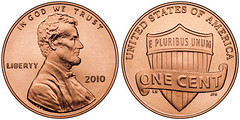 Moneybags Dad got asked to foot some prize money. After rooting through my pockets I came up with these prizes for 1st, 2nd and 3rd place: a dollar, fifty cents, and A SHINY NEW PENNY! They had a lot of fun with the concept of a shiny new penny as a prize. Maybe next time that'll be the FIRST place prize.
Moneybags Dad got asked to foot some prize money. After rooting through my pockets I came up with these prizes for 1st, 2nd and 3rd place: a dollar, fifty cents, and A SHINY NEW PENNY! They had a lot of fun with the concept of a shiny new penny as a prize. Maybe next time that'll be the FIRST place prize.
Wednesday morning I stopped at Walmart on the way to work and asked for some cash back at the register to save a trip to the ATM. I asked for $60, but instead of the three 20s the ATM would have given me, I got a $50 and a $10. It's not like I've never seen a $50 before, but I rarely have them since the ATM doesn't. I looked it over and immediately noticed the stamped chop on the back.
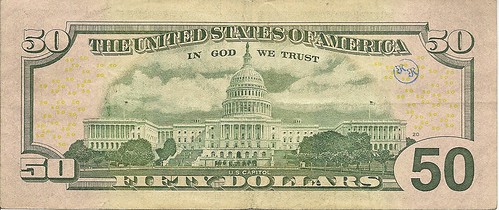
It looked like two R's in a circle, stamped in the upper right corner of the back of the note. Below is a closeup of the chop, along with an image of one we discussed before, also on a $50 bill. In that article, Tom DeLorey wrote:
Here at Harlan Berk's coin store in downtown Chicago, it is not unusual to see $50 and $100 bills with small rubber stamps on them. They are presumably bankers' and money exchangers' marks from overseas, indicating that the bank or exchanger in question has examined the note and found it to be genuine. It is the equivalent of the Chinese chop mark on 19th century crown-sized coins such as Trade Dollars.

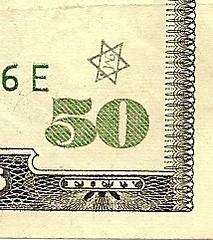
To read the earlier E-Sylum article, see: STAR STAMPS ON PAPER MONEY: MODERN CHOP MARKS (www.coinbooks.org/esylum_v11n36a10.html)
On Wednesday evening I took my father-in-law to see the new movie True Grit. There were two scenes of numismatic interest. In one, $300 changes hands. It was all paper money, but did not look to me like typical stage money. The glimpse was fleeting, but these looked like "antiqued" paper repros of 1860s Demand Notes and large-size National Bank Notes. I believe the scene was set in about 1878.
The other numismatic scene involved what the characters called "a California gold piece." The scene was also set around 1878. When the piece was finally seen on screen it was a squarish ingot with stamped lettering. It went by so fast I was unable to make out what it said. The item appeared to have the bright brassy color of a repro rather than the dull yellow of real gold.
Has anyone else seen these scenes?
On Sunday I had a couple hours in the afternoon to work on The E-Sylum and managed to get most of it done so I could get to bed at a decent hour tonight. I went out to dinner with my family and while waiting for the check I got some new emails from Pete Smith and Dick Doty. I paid our bill with that chopped $50 note.
Once the kids were in bed I finished The E-Sylum and worked on plans for the next meeting of Nummis Nova, my Northern Virginia numismatic social group. The meeting is scheduled for Tuesday, but there's a forecast of snow and I exchanged emails with a couple folks about possibly rescheduling. As a Yankee I tend not to worry too much about driving in snow, but it's a Big Deal down here. When everybody's skittish about snow it's not good for anyone.
I recalled fondly the two or three times I held my steering wheel tight and tensely watched my rear-view mirror while my car slid backwards down an ice-slicked hill. Never hit anything, thankfully. But those were quiet residential streets, not the Beltway at rush hour.
I wondered what folks not used to snow would think about driving in snow on Pittsburgh's hills. I've seen nothing in this part of Virginia that's close to a Pittsburgh hill. Visiting our old neighbors in Pittsburgh over the holiday, we parked our family van in their driveway. We were all leaning back in our seats like astronauts strapped in a space capsule ready for launch. Before we moved to Virginia, we wouldn't have even noticed.
The only remaining numismatic item to report relates to literature. If only it weren't a dream. I came down with a bug and left work early Thursday. I went to bed at 5pm for a nap, but didn't get up until 6:30 Friday morning. I felt better and went to work, but had a relapse the next night. Not feeling well, I hit the sack again.
And early Saturday morning, the same day as the Kolbe & Fanning numismatic literature sale in New York, I dreamt that I'd purchased a 19th century numismatist's desk, complete with numismatic books, periodicals, catalogs and correspondence of the day. We're talking a big, highboy-style desk here, with lots of shelves and compartments.
Don't ask me how it got shipped here - in a giant box with a crapload of bubble wrap? Anyway, I'm opening book after book and exploring nook after cranny having great fun discovering neat numismatic literature. Then George Kolbe shows up, apparently having teleported himself straight in from New York. As we looked through everything together, George rarely looked up, saying little more than, "hmmmm".
Then I woke up. Hmmmm, indeed.
ROBERT HENDERSON AND THE SHERATON COIN COMPANY
In an email on another topic this week, Dave Bowers wrote:
Robert Henderson, founder of the Sheraton Hotel chain, was a notable collector of U.S. large cents and in 1960 was the keynote speaker at the American Numismatic Association convention banquet in Boston. He also financed the Sheraton Coin Co., in Boston, which operated for a few years.

Click on the images below to read larger versions on our Flickr archive. Check out the prices - XF Chain Cents for $300! (I'll take two!):
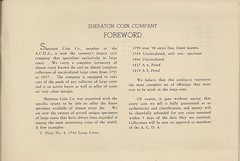
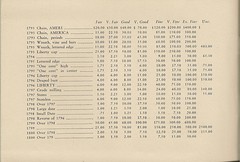
MARK HOROWITZ' LARGE CENT LEARNING EXPERIENCE
 I have to share the highlight of my learning experience with you: I was eating dinner with my wife, daughter and her boyfriend, when the phone rang and my wife answered and took a message. "It was Dan Holmes calling about a 1799 penny," she said. "OK", I said and went back to talking to my daughter who we hadn't seen for awhile.
I have to share the highlight of my learning experience with you: I was eating dinner with my wife, daughter and her boyfriend, when the phone rang and my wife answered and took a message. "It was Dan Holmes calling about a 1799 penny," she said. "OK", I said and went back to talking to my daughter who we hadn't seen for awhile.
About six bites later the light bulb went off, and I erupted with "Did you say Dan Holmes?!!!" I couldn't believe it. It was like Tom Brady calling me and saying, "I was walking by your pick-up football game and thought I'd call to give you some tips on your passing."
I proceeded to tell everyone why I was so excited, since even as a novice, I had heard of Dan Holmes and had the catalogue for Part 1 of his sale. I told them about his long accumulation process and the beauty of his collection, the first million dollar large cent, and the total sales figure for Part 1.
They sat there wide-eyed. I had never seen my family so excited about my coin collecting! And when I called Dan back, I couldn't believe that he had taken the time to track down my phone number and call me. One of the first things he said was, "Don't be too hard on yourself, anyone who has collected large cents for any length of time will probably have bought a fake 1799 or at least come across one." And then he offered to send me the catalog of Part 3 of his auction because it contained 11 examples of fakes with descriptions that I might learn from.
For me, Dan's call and all of your responses here in Region 8 are part of what makes this hobby so exciting for me. It also represents the best of the American spirit of clubs where members help each other out and educate those who are new to the hobby. Thanks to you all!
I never had the opportunity to meet Harry in person, but it's another example of how a hobby like ours breaks down barriers - lawyers, students, cab drivers, pipefitters and gazillionaires alike all share a common bond, babbling like excited schoolgirls over their hobby. Viva numismatics! -Editor
To view the complete lot description, see: Lot 352. 1799 S-189 R2+ Normal Date. (images.goldbergauctions.com/php/lot_auc.php?site=1&sale=54&lot=352)
THE BOOK BAZARRE
STEPPING THE MAST: COINS OF THE BLUENOSE II
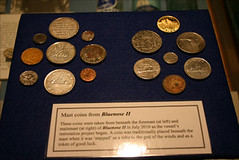 When Bluenose II sets sail again in 2012, she'll have plenty of good luck beneath her sails — literally.
When Bluenose II sets sail again in 2012, she'll have plenty of good luck beneath her sails — literally.
In keeping with seafaring tradition, a cache of coins meant to bring the ship safe sailing was placed beneath each of the schooner's two masts when it was built. They include a Spanish doubloon from 1791 and a special edition gold coin worth $200.
Those coins, removed last July when the ship was prepared for reconstruction in Lunenburg, are now on display in the Bluenose Room of the Fisheries Museum of the Atlantic on the town's waterfront. Some of them will be put back under the masts when the ship's restoration is finished in the spring of 2012.
"It was tradition to place a coin beneath the mast of a sailing ship to appease the god of wind," Ralph Getson, fisheries museum curator, said Friday.
Brian and Phil Backman in their book Bluenose wrote of "setting the sticks" of Bluenose II in 1963, he said.
"As each was settled into its step, a small cache of coins was placed beneath, traditionally a sop to the winds of fortune," the book states. "Included were Canadian silver dollars and 10-cent pieces — the latter bearing the effigy of Bluenose — launch-marking medallions and some rare, old Spanish doubloons and pieces of eight, having a special significance because of the Oland family's Spanish ancestry."
Getson said workers didn't find any pieces of eight but they did find 10 coins under the foremast and six under the mainmast. You can see the ship's director of operations, Capt. Wayne Walters, display them on www.youtube.com by typing in Bluenose II coins.
Coins found under the foremast include a 1963 Bluenose II coin made when the ship was launched, a 1963 silver dollar, a 1978 coin commemorating Lunenburg's 225th anniversary and a 1997 silver dollar commemorating the Canada-Russia hockey series. It was put there by the Bluenose II Preservation Trust Society when it replaced that mast in 1997.
The Spanish silver doubloon was found under the mainmast, along with a 1967 silver dollar and the $200 special edition gold coin.
To watch the YouTube video, see: Bluenose II Project - Mast Coins (www.youtube.com/watch?v=vylPcGXQmAc)
To read the complete article, see: Lucky coins and fair winds (/thechronicleherald.ca/NovaScotia/1220902.html)
SPELLING MISTAKE FOUND ON 2005 £2 COIN
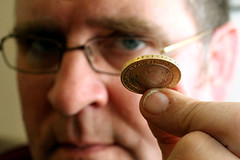 The coin – made to mark the 400th anniversary of the Gunpowder plot – has the words ‘Pemember the fifth of November' engraved around the outer rim.
The coin – made to mark the 400th anniversary of the Gunpowder plot – has the words ‘Pemember the fifth of November' engraved around the outer rim.
Eagle-eyed collector Albi Pinnion, 46, noticed the mistake after being handed a £2 coin in change at his local pub in Ousden, Suffolk.
Remarkably, the coin was produced in 2005 and the mistake has gone un-noticed for five years.
The misprinted currency has now become hot property among coin collectors and are selling for over £10 on eBay.
Mr Pinnion said: "When looking at the coin I just happened to notice the incorrect spelling.

"It is not the sort of thing most people would go out of their way to check so that may be why it has taken so long for one to come to light.
"I originally emailed and wrote letters to the Royal Mint but they did not want to acknowledge the coin for some reason.
"I noticed on eBay that a few more of them have now been found."
The Royal Mint has admitted the mistake but refused to disclose how many might be in circulation.
A spokesman said: "It's likely to be a consequence of the production process.
"It's very, very infrequent that we issue coins with an error. We have quality control to detect any defects."
Coin mint error coins are commonly the result of deterioration of the minting equipment, accidents or malfunctions.
A Flickr visitor remarked:
I have two of these and it is not that they have been misspelt, but that they have been poorly struck. On mine you can just see the faintest hint of the stroke of the R which makes it look like a P.
To read the complete article, see: £2 coin has spelling mistake on it (swns.com/2-coin-has-spelling-mistake-on-it-071033.html#)
To read the earlier E-Sylum article, see: HEADS ROLL AT THE CHILEAN MINT OVER COIN'S SPELLING MISTAKE (www.coinbooks.org/esylum_v13n07a25.html)
PARKS CANADA COIN CRITICIZED
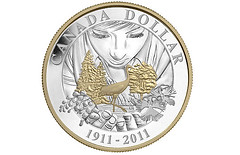 Canada's 2011 silver dollar commemorates the centennial of Parks Canada by showing endangered species — with one hiccup: Half the species on the coin aren't found in or near any parks.
Canada's 2011 silver dollar commemorates the centennial of Parks Canada by showing endangered species — with one hiccup: Half the species on the coin aren't found in or near any parks.
The selection has puzzled some naturalists, who wonder why the coin doesn't show more of the hundreds of species that are truly protected by national parks.
The silver dollar, which will sell to collectors for $55.95, shows a group of four species: the whooping crane, western prairie fringed orchid, southern maidenhair fern and Kentucky coffee tree.
Two of these do occur in Canada's parks: The whooping crane in Wood Buffalo National Park — which stretches from northern Alberta into the Northwest Territories — and the Kentucky coffee tree in Pelee Island Park, about 60 kilometres southeast of Windsor, Ont.
Royal Canadian Mint spokesman Alex Reeves said the Mint is aware that two of the pictured species don't come from parks. But he said that's not the point.
The coin is intended to recognize the parks' role in protecting endangered wildlife, and it doesn't matter where the individual examples come from, he said.
Michael Runtz, who teaches biology at Carleton University, also criticized the selection. "If we're celebrating national parks with species not found in those parks, I think it's absolutely ridiculous."
To read the complete article, see:
Parks Canada coin 'absolutely ridiculous,' critics say
(www.vancouversun.com/travel/Parks+Canada+coin+absolutely
+ridiculous+critics/4075254/story.html)
ESTONIA REARRANGES THE NUMISMATIC MAP
 Estonia pulled back from redrawing its border with Russia on its new Euro coin. An earlier version of a map on the back of the coin included part of Russia within Estonia. However, the final version has corrected the error.
At first the bank of Estonia suggested that the borders were just the painter's artistic perception of Estonia's borders. The Estonian ambassador to Russia insists that the map now properly represents the border and no Russian territory has been seized.
Estonia pulled back from redrawing its border with Russia on its new Euro coin. An earlier version of a map on the back of the coin included part of Russia within Estonia. However, the final version has corrected the error.
At first the bank of Estonia suggested that the borders were just the painter's artistic perception of Estonia's borders. The Estonian ambassador to Russia insists that the map now properly represents the border and no Russian territory has been seized.
The Setos an Estonia Ethnic group claim that some areas should belong in Estonia that are not shown as such. There is still a dispute among some about where the border should be.
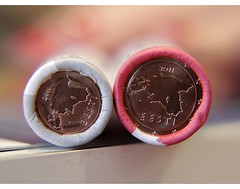 Estonia joined the Euro area on January first and the coins were issued then. The moral of the story is that you should not draw maps on coins!
Estonia joined the Euro area on January first and the coins were issued then. The moral of the story is that you should not draw maps on coins!
To read the complete article, see:
Estonia engages in brief numismatic aggression against Russia!
(www.allvoices.com/contributed-news/7820857-estonia-engages
-in-brief-numismatic-aggression-against-russia)
TOURISTS LOVE ZIMBABWE 100 TRILLION DOLLAR BANKNOTES
 Western visitors to Zimbabwe are looking for zeros. They're snapping up old, defunct Zimbabwe bank notes, most notably the one hundred trillion Zimbabwe dollar bill, as an economic souvenir.
Western visitors to Zimbabwe are looking for zeros. They're snapping up old, defunct Zimbabwe bank notes, most notably the one hundred trillion Zimbabwe dollar bill, as an economic souvenir.
The one hundred trillion Zimbabwe dollar bill, which at 100 followed by 12 zeros is the highest denomination, now sells for $5, depending on its condition. That bill and others — among them millions, billions and trillions, were abandoned nearly two years ago, when the American dollar became legal tender in the hopes of killing off the record inflation that caused all those zeros.
"I had to have one," said Janice Waas on a visit to the northwestern resort town of Victoria Falls. "The numbers are mind bending." She got her so-called "Zimdollar" in pristine condition, from a street vendor who usually sells African carvings.
"It's perfect if you like puzzles, calculus and things like Rubik's Cube," she said.
Janice's husband Thomas Waas, a physicist and engineer from Germany, said if the population of the world is 7 billion people, every single person could be a given thousands of old Zimbabwe dollars from this single 100 trillion note.
Janice Waas said Westerners were buying the bills for their curiosity value. An Australian wanted one to display in his local bar back home.
Street vendors said visitors had been so intrigued by the Zimbabwe bills that they were now running out of them, two years after a power sharing deal between longtime ruler President Robert Mugabe and the former opposition leader, Prime Minister Morgan Tsvangirai, made the old currency redundant.
To read the complete article, see: Visitors Snap Up 100 Trillion Zimbabwe Bank Notes (www.npr.org/templates/story/story.php?storyId=132580382)
FEATURED WEB SITE: COIN PROJECT
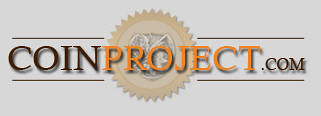
This week's Featured Web Site is Alfredo De La Fe's Coin Project. He writes:
The project is a data-driven web site developed by professional programmers with the support of over 100 volunteer numismatists, many of them the best in their fields. The result is an easily updatable, expandable and searchable resource that already contains nearly 40,000 coin records (with an additional 300,000+ pending). Refining and standardizing issuers, regions and cities for each type is a high priority; the site will have the most comprehensive and accurate set of these classifications to be found anywhere.
As a not-for-profit collaborative effort, Coin Project will rely on financial support by selling banner advertising and private donations. Coin Project will never charge a fee to use any of its resources. Strategic guidance is provided by a board of advisors with day-to-day management decisions made by a project executive.
There is still much work to be done, such as the editing and approving of a huge number of pending submissions from individuals, major institutions and commercial sources. For this work we require more volunteers and, now that the site is maturing, is a good time for new volunteers to join and contribute.
Please visit the website at http://coinproject.com and give us your comments. If you feel you can contribute some time toward processing the images and data, let me know and I'll arrange credentials and provide you with more details on the inner workings of the project.
coinproject.com
